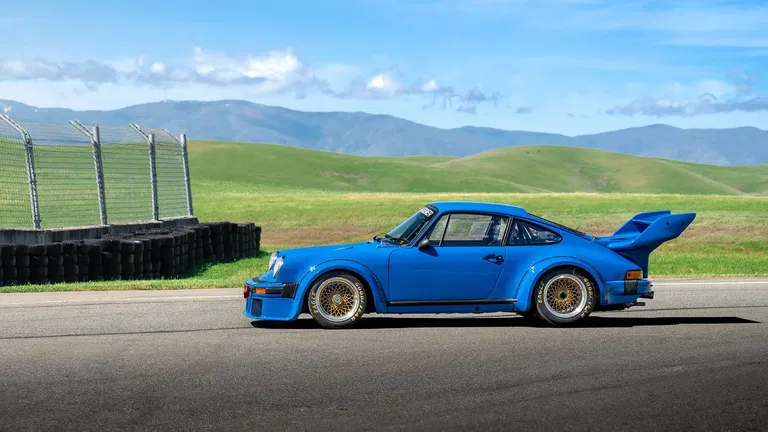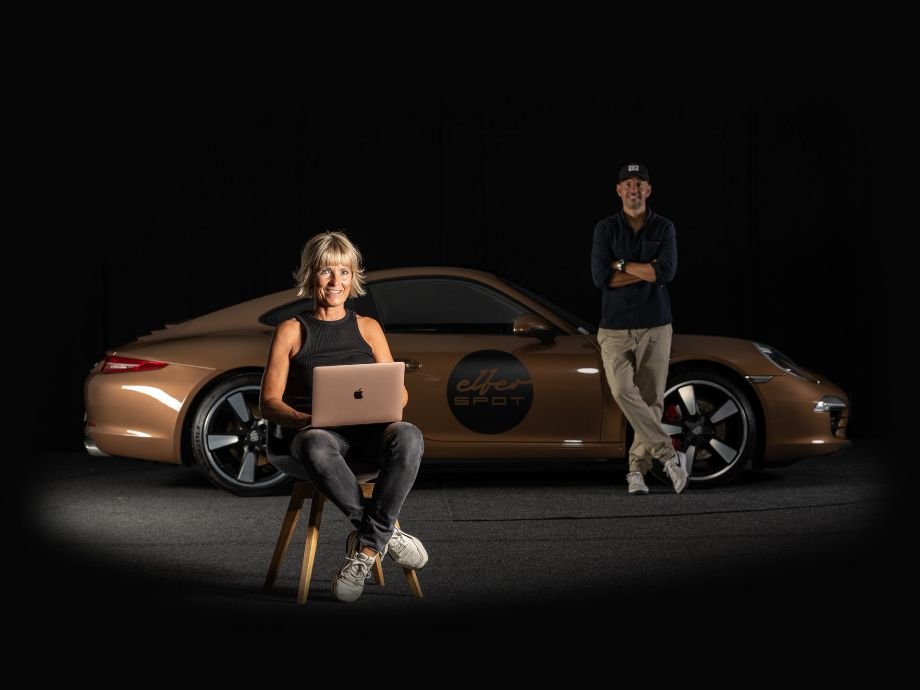Under FIA Group 4 regulations the minimum vehicle weight was 2470 pounds, which was just under the production 930’s curb weight, making the 934 the heaviest race car that Porsche had ever made. Beginning with a fully assembled production 930 as its base, the 934 added a new front spoiler to accommodate a large center mounted oil cooler and intakes for air and brake cooling. The suspension was converted to solid mounts with nylon bushings, adjustable anti-roll bars and was fitted with stronger hubs adapted to allow the use of center lock wheels. Wider bolt on wheel arches allowed the use of massive 16x 10.5 and 12.5″ BBS wheels and wider tires to increase mechanical grip, and brakes borrowed from the 917 were fitted. At the front, a 120 liter fuel tank monopolized much of the space in the front trunk along with an oil tank and ducts leading to the rear intercoolers. The interior was fitted with the mandatory roll cage and single racing seat, but retained full door panels and electric windows. The stock dashboard was replaced by a simplified version with a manual boost pressure regulator knob and auxiliary gauges.
The most drastic changes were to the standard 930/75 engine. The engine block, crankshaft, cylinders, cylinder heads, connecting rods all remained either the same or as close to stock as per the FIA regulations, but new pistons were fitted. The standard ignition and mechanical injection systems had to be retained per the FIA regulations. The engine fan was mounted horizontally on top of the engine, and water-cooled intercoolers mounted on the left and right side of the fan. With 20 psi from the single large KKK turbocharger, the engine was capable of putting out approximately 485 horsepower, but it was reported that the top teams were putting out nearly 580 horsepower through tuning and modifications to the wastegate. The four-speed gearbox was available with different gear ratio options depending on the racetrack it was intended to run on. A separate oil cooler for the gearbox was housed in the rear spoiler.
This example left the factory in Zuffenhausen as the 9th 934 produced with the chassis number 9306700166 and production number 106.4445. It was finished in the Valliant Green livery and became part of the Kremer Racing team’s stable for the 1976 and 1977 seasons. Bob Wollek was behind the wheel for every race in the German National Championship in 1976 and consistently finished on the podium in each race- finishing fourth in the European Grant Touring category with a total of 45 points despite not participating in all of the races. During this period, chassis 9306700166 was damaged in an accident so Kremer stripped the chassis and utilized a brand new tub, chassis 006 0022, to rebuild the car and prepare it for the remainder of the season.
Most notably after its reconstruction, chassis 006 0022 was registered for the 1977 24 Hours of Le Mans with Bob Wollek, Philippe Gurdjian, and Jean-Pierre “Steve” Wielemans as its drivers to compete in the Group 4 class. For the famed race the body remained in white but received the colors of its main sponsor, Burton of London, with large blue swatches with simulated stitches on the nose and along the front and rear quarters, and an approximately life-sized caricature of a man in a blue suit on the driver and passenger doors. The caricature was aligned with the seating position of the driver and his shoulder aligned with the bottom of the window so that when the driver was in the car, the driver’s shoulders and helmet aligned with the graphic. The idea for the livery is accredited to Gurdijan, who was a prominent promoter of motorsport and Formula 1 events and eventually went on to chair the Paul Ricard hotel and circuit complex. By the end of the grueling 24-hour race Wollek, Gurdijan and “Steve” had traveled more than 4,000kms and 298 laps at an average speed of 169.419 km/h and claimed a first-in-class victory and an impressive seventh-place overall finish.
In the later half of the 1977 season, 006 0022 was rented by the team to various privateer drivers such as Louis Krages, better known by the pseudonym “John Winter”, who claimed two second-place finishes and three third-place finishes in the German National Championship. In 1978 Fritz Englehardt, who was also known as “Harry Hirsch”, purchased the car and competed with chassis 006 0022 in the German National Championship until 1980 when he sold it to an amateur privateer driver named Peter Pospieszcyk the same year. The competitive racing career of chassis 0060022 came to an end at the end of the 1980 racing season. Like many specialty European racing cars of the period, this 934 is said to have been sold to Japan in 1981.
In 2006, Kremer Racing restored chassis 006 0022. Their records note a complete and thorough review of all major systems of the car. Before beginning work, Kremer noted that the car had been static for 25 years, properly lining up with its sale to Japan in 1981, and that a complete restoration of the vehicle would need to be completed. In addition to the necessary mechanical work, they were also tasked with returning it to the livery it wore during its most triumphant moment as the Group 4 class winner at the 1977 Le Mans 24 Hours. Naturally proud of their work and their previous history with the car, Kremer requested that they be able to display this 934 for three months following the restoration. After a time following this display period, it was sold to in 2009 to Arizona based collector, Jim Edwards. Judging by the entry stickers on its windshield, 934 chassis 0060022 has been enjoyed properly since restoration with attendance at Rennsport IV, V, and VI as well as the Monterey Historic Races in 2009.
This 934 has undergone a recent service with a compression and leakdown check, a full fluid change consisting of engine oil, transmission fluid, and brake fluid with filter changes, a full fuel system cleaning, fresh Avon racing slick tires and a new battery.










































































































